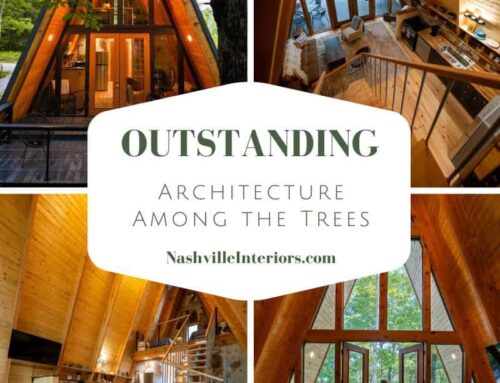By Elliott Wenzler
To David Condra, the Green Hills home he shares with his wife Estelle is reminiscent of the caves he has explored throughout his life.
The home isn’t dark or underground, though it resembles a cave because of the way it starts with an unassuming front door that opens up into a vast and inviting space past the entry, filled with interesting architectural details and design elements.
From the custom wood front door to the lack of right angles throughout the entire home, visitors can’t help but notice it’s an uncommon space as they venture from room to room.
The Condras met in Estelle’s home country of South Africa before moving back to Nashville, where David was raised. Once back in Middle Tennessee they stumbled upon the open lot, which was overgrown and on the edge of a steep hill, after moving around Nashville five times in three years. Immediately they knew the jungle-like land was their future home and have lived there since they built in 1983.
“We could tell that we could build something that would be different,” Estelle said. “Always I’m thrilled if something is unusual or different or your own idea.”
Not only is the home itself unique, so is the way it was designed and built. The couple hired a construction team and a 26-year-old architect, neither of which had ever worked on a residential property. They wanted the home to be a part of the surrounding nature and to be able to grow with them, David said. The architect, Lisa Bradley, designed the home to include multiple stages of development so they could add on as needed, David said.
To incorporate nature, the home sits in the deep part of the lot behind the steep hill, making it mostly concealed from the street view and nestled into the natural growth.
A tree grows through the back deck, a balcony from the master bedroom acts as a canopy among a few branches, and instead of a lawn, the parts of the property outside of the deck looks more like a forest floor. One priority while building was to save as many trees as possible, David said.
They didn’t want to try to make the area into something it’s not.
“It’s what wanted to grow there,” he said.
When building the home, the couple had something else very important to keep in mind with the design. Estelle has a rare, degenerative eye disease, called retinitis pigmentosa, which caused her to lose her eyesight completely. They needed her home to be a place that she could learn fully and feel comfortable in.
“He was absolutely determined I would learn this place,” Estelle said.
The floors and walls in each room have distinct textures so she can more easily navigate the home. David, who worked in Nashville’s technology industry before his recent retirement, added many other features to help Estelle feel secure.
When the curtains on what they call their “African tree house” are pulled back, another dimension of the home reveals itself: specialized tech designed to allow Estelle to navigate the home and feel safe when David isn’t there.
Alarms on all the doors announce when and where they’re opened, a sensor in the driveway notifies when cars pull in and a camera connected to David’s phone streams a video of the front door.
For convenience, there’s a Nest thermometer which can be controlled by multiple Amazon Echos throughout the house. Through voice commands, the devices make calling for an Uber, listening to the radio or phoning a friend much easier for Estelle.
David considers himself as a gadget guy and is always looking for new ways to make life easier for Estelle. When she couldn’t hear the birds from the kitchen, David installed a button that would open the unreachable windows easily. The project also fit in with the couple’s attempt to bring the outside in.
“It makes a huge difference that the home is so (specifically designed),” Estelle said.
After living there for 35 years, David and Estelle have made their home an accurate expression of their lives together, and they don’t plan on leaving, Estelle said.
The interior of the home is dotted with a multitude of sculptures, African artifacts, artisan bowls and photographs from their trips around the world. Most of the art is three dimensional so Estelle can enjoy and experience it even without vision. Portuguese marble, bronze, horn and other materials offer an array of textures for her to take in.
“It’s first and foremost artistic, then with an emphasis on African pieces,” she said.












Leave A Comment
You must be logged in to post a comment.